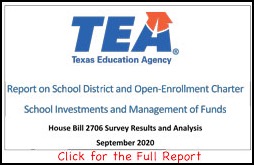In a Report to the Legislature
TEA Recommends Change in Law to Require
Improved ISD/Charter Investments Reporting
A just-released TEA report to the Legislature recommends changes in state law to require ISDs and charter districts to disclose “fully and in detail” — in their annual financial reports — info about their investments.
The recommendation is contained in the TEA’s Report on School District and Open-Enrollment Charter School Investments and Management of Funds report that was mandated by 2019’s HB2706.
FY2018 Data
The report is largely based on a TEA survey of ISDs and charter districts on investments and selected other financial audited data for Fiscal Year 2018 (FY2018) — which ended (depending on the entity’s annual budget cycle) on either June 30 or Aug. 31, 2018.
Overall, the report found that ISDs and charters are investing and managing public funds in a prudent manner.
But, the report adds that agency staff learned while helping some of the charter districts and ISDs complete the survey that some of them were not fully disclosing all of their investments in their required annual financial reports, contrary to guidance issued by the Government Accounting Standards Board (GASB).
The report recommends several sections of state law that could be amended by lawmakers to improve the required reporting of investments — and cites various sections of GASB guidance that could be used as a reference.
Generated $680.5 Million
The 44 charter districts and 714 ISDs that said in the survey that they had investment instruments that met state Public Funds Investment Act requirements during FY2018 reported that their investment portfolios amounting to $31.05 billion generated a net $680.5 million of investment returns (after deducting $2.23 million in fees).
A total of 83 of the responding charter districts and 198 ISDs reported having no investments — and no responses were received from 43 charter districts and 109 ISDs.
Other Findings
Other findings from the survey, which also sought information about cash management, fund balances and other related items, included:
Charters and ISDs were most likely to hold investments with a maturity date of less than a year.
ISDs were mostly in investment pools and public funds investment pools, which has the advantage of offering guaranteed next day liquidity and low fees.
Most charter district investments were in certificates of deposit.
The report hints that the differences in investment strategies may be because state law places greater restrictions on how ISDs can invest their funds, resulting in ISDs and charters having differing investment goals and strategies.
- ISDs experience “ebbs and flows” of funding in that they receive their most significant cash inflows in December, January and February — months when property tax revenues are received.
- Meanwhile, because charters receive state funding payments on a monthly basis, their cash flow balances remain relatively consistent from the beginning to the end of each fiscal year (except in times when they have more cash on hand due to issuing bonds).
- In evaluating ISD fund balances (which are called “net assets” for charters due to a different accounting standard applied to them), the report cautions that, for a variety of reasons, fund balances and investments do not always represent liquid cash that is immediately accessible for operations.
The report notes that the safety and liquidity of public funds should come first in utilizing investment strategies and procedures, and overrides the secondary goal of generating an additional revenue stream.
